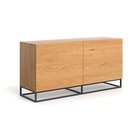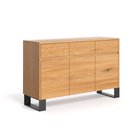With rising eco-consciousness among consumers, the sustainability of wood has become an important purchasing consideration, especially for furniture and home building. But what exactly does “sustainable wood” mean and why does it matter?
What is Sustainable Wood?
Sustainable wood comes from responsibly managed forests that balance the rate of tree harvesting and forest regrowth. Regulated forestry aims to minimize environmental impact and provide economic benefits to local communities. The forests are managed to conserve biodiversity, water resources, soils, and ecological functions.
For wood to be certified sustainable, it must come from a forest with an internationally recognized ethical forestry certification, like the Forest Stewardship Council (FSC) or the Sustainable Forestry Initiative (SFI). These certifications verify that strict standards are followed when harvesting trees and regenerating the forests.
Logs from sustainably managed forests are tracked through the supply chain with chain-of-custody certifications. This ensures that the sustainably sourced raw materials are segregated from non-certified wood and that the finished products can carry a sustainable certification claim.
Why Choose Responsibly Sourced Wood?
Opting for third-party certified renewable wood has many benefits:
- Preserves forest ecosystems and wildlife habitats. Irresponsible logging can cause deforestation, habitat loss, and reduction in biodiversity.
- Protects indigenous communities. Sustainable practices require fair treatment of workers as well as cooperating with indigenous people dependent on the forests.
- Reduces pollution and waste. Reclaimed forestry techniques minimize impacts like soil erosion, air and water pollution, and damage to forest floors. There is also less wood waste.
- Conserves natural resources. The cycle of planting new trees to replace those cut down helps provide an ongoing supply of renewable timber.
- Promotes local economies. Workers in the area get steady employment and income from alternative forestry.
- Provides transparency and accountability. Third-party audits verify that sustainability standards are actually practiced on the ground.
Eco-Friendly Alternatives
For those looking to reduce their reliance on harvesting from forests, there are several ethical wood alternatives. Composite lumber mixes recycled timber fibers or sawdust with recycled plastic resins to create durable, eco-friendly boards. These composites prevent waste from going to landfills and require no new trees. Reclaimed lumber repurposes old barn beams, deconstructed building materials, and other salvaged wood. Using reclaimed wood gives a unique vintage look while diverting waste.
Some companies also make flooring, furniture, and countertops with agricultural residuals like wheat straw, sunflower hulls, or mushroom mycelium. These innovative products provide sustainability without cutting down forests. Though not technically wood, they offer natural, renewable options for many applications.
Popular Renewable Wood Options
Many sustainable woods are available for residential and commercial projects:
- Oak comes from abundant natural forests and managed oak groves. It is fashioned into hardwood flooring, furniture, cabinets, and trim work. Is oak sustainable? Yes, oak can be sustainably sourced from certified oak forests.
- Maple grows prolifically across North America's hardwood forests. It is often seen in flooring, cabinets, cutting boards, and butcher blocks.
- Bamboo is actually a fast-growing grass but is used similarly to wood. Bamboo is made into flooring, furniture, fabrics, and more.
- Pine's quick growth makes it one of the most sustainable softwoods. It is popular for construction lumber as well as furniture and paneling. Is pine sustainable? Yes, pine can be a very sustainable timber choice when properly managed.
- Cedar and redwood come from sustainably managed Pacific coastal forests and are used for decks, fencing, and outdoor projects.
Choosing sustainable woods promotes responsible forest management while letting you enjoy beautiful, eco-friendly materials. Look for trusted sustainability certifications when selecting wood products. Supporting sustainably sourced lumber is an investment in the future of our forests.
Using Wood Efficiently
When working on building or furniture projects using wood, keep sustainability in mind. Carefully plan out your design to minimize waste and scrap wood. Opt for composite, recycled, or reclaimed wood alternatives when possible. Use every part of the lumber by repurposing scraps for smaller items or woodchips for landscaping. When using virgin lumber, choose FSC or SFI-certified sustainably harvested wood.
Use untreated, non-toxic finishes and adhesives to avoid pollution. Practice responsible habits like switching off saws when not in use, capturing sawdust, and cleaning up. Dispose of any waste wood properly or better yet, reuse or recycle it. Following sustainable principles shows respect for wooden resources and reduces your environmental impact from start to finish.


































